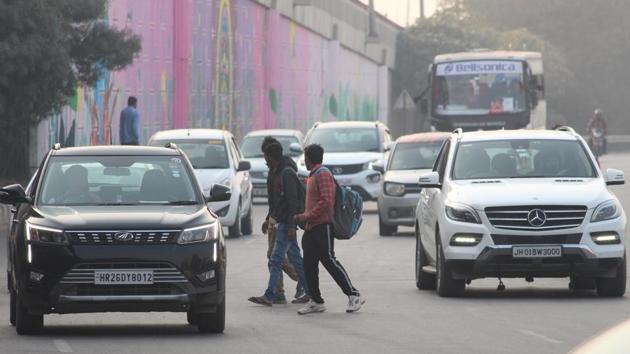Why on-road safety must supersede vehicular speed in Gurugram
Its time to prioritise safety over speed. Only then we can make Gurugram a city where people walk by choice and not compulsion.
In my last article, I wrote about the third Global Ministerial Conference on Road Safety in Stockholm, Sweden. One of the biggest takeaways from the Stockholm Declaration, the conference’s outcome documents, was to design and enforce a maxim, the mayor of London, Sadiq Khan, as part of his ‘Vision Zero’ commitment, reduced the traffic speed in central London to 30 kmph. The mayor feels (rightly) that lowering speed limits will save lives, and at the same time, it will make walking and cycling much more appealing to citizens. However, back in Gurugram, a trail intersection at Rajiv Chowk designed to provide a safe facility for pedestrian crossing and non-motorised traffic was removed within hours, fearing the reduction in speed would cause traffic congestion.

Reducing speed to improve safety does not come naturally to our citizens, but not for lack of examples in India. The HP Petrol Pump intersection in Bandra, a western suburb of Mumbai, is one such example. The intersection caters to 70,000 vehicles and nearly 50,000 pedestrians every day. It was re-modelled permanently last year for the safe mobility of all road users. Similarly, Rohtak in Haryana has also made a successful transition by redesigning one of its dangerous intersections, HUDA Park—New Bus Stand Junction.
Gurugram has also tried to redesign some of its dangerous intersections, be it Bakhtawar Chowk, Cyber City Junction, Rajiv Chowk, etc. However, trial runs for safe designs at these locations have not lasted beyond a couple of hours or days. So, why does safety neve comes first in Gurugram, especially when it comes to road design? Let me highlight three reasons why.
Speed incorrectly overtakes safety
The safe systems approach advocates that safety should supersede everything, including mobility. This is where the problem starts. City agencies are more concerned with moving motor vehicles as quickly as possible, even if it comes at the cost of pedestrians and cyclists. Last year’s data of all pedestrian deaths in Gurugram shows that over 90% of them took place either on National Highways, State Highways or the Golf Course Road, all of which are high-speed corridors. Therefore, it is essential that speed along these road stretches, especially at the intersection, needs to brought down to a safe limit, and this can be done quickly via good design. However, any effort to increase speed will only lead to an increase in traffic crashes, especially those involving vulnerable road users.
Inadequate implementation time
Any new design takes time, and therefore its evaluation should only take place after enough time has been given for roll-out. This is because road users need to understand the new design and change their behaviour accordingly. This is the reason why the Mumbai junction redesign was tested very strictly for over two months and then evaluated and fine-tuned for two years before being made permanent. Similarly, the junction work in Rohtak was testing firmly for two weeks before the decision around whether the new design works was taken. However, in Gurugram, the choice is made in a few minutes or hours, and the latest plan is done away. Therefore, what Gurugram needs is to provide enough time for implementation and only then decide if it works or not.
Incorrect evaluation criteria
Last but not least is to understand how to evaluate the design. Agencies in Gurugram have assessed the design based on its impact on traffic congestion, and that’s completely wrong. We need to redesign our city roads for the safe mobility of all road users and not only people who use motor vehicles. Yes, we cannot ignore the impact of the movement of motor vehicles, but that should not be the sole criterion for evaluation. The junction design in Mumbai looked at the flow of both pedestrians and motor vehicles.
Similarly, the junction design in Rohtak looked at the safety and mobility of road users before deciding whether the plan worked. Therefore, Gurugram also needs to take another look at the approach of design evaluation. If a new design promotes mobility but not safety, then it should never be implemented. However, if it increases safety and reduces speed—so bit it.
The predominant mode of transport in our cities is walking. In Gurugram, one-third of people walk for their transport needs, and we need to remember that. What we also need to know is the fact that if a pedestrian is hit by a car at 30 kmph, his/her chance of survival is 90%. However, if the same collision takes place at 50 kmph, which is the legal speed limit, the likelihood is only 15%.
Therefore, its time to prioritise safety over speed. Only then we can make Gurugram a city where people walk by choice and not compulsion.
@amitbhatt4u
Amit Bhatt is the director- integrated transport, WRI India
Stay updated with all the Breaking News and Latest News from Mumbai. Click here for comprehensive coverage of top Cities including Bengaluru, Delhi, Hyderabad, and more across India along with Stay informed on the latest happenings in World News.
Stay updated with all the Breaking News and Latest News from Mumbai. Click here for comprehensive coverage of top Cities including Bengaluru, Delhi, Hyderabad, and more across India along with Stay informed on the latest happenings in World News.






